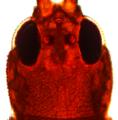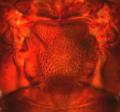Stictothrips maculatus
Recognition data
Distinguishing features
Both sexes fully winged. Body brown with chalky-white line laterally from eyes along abdomen, also chalky marks on femora; tarsi light brown, tibiae with base and apex yellow; antennae brown with segments III and V yellow; fore wing pale. Head about as wide as long, wider across cheeks than across eyes, projecting slightly in front of eyes; surface reticulate, with two longitudinal rows of short, broad capitate setae; maxillary stylets retracted to eyes, about one fifth of head width apart with maxillary bridge present. Antennae 8-segmented; segment III with one sensorium, IV with two sensoria; segment VIII slender and narrowed to base. Pronotum with five pairs of short fan-shaped major setae, also one pair of similar setae posteromedially; surface with granulate sculpture. Fore tarsus with small, slightly hooked tooth. Metanotum with coarsely granulate sculpture, about 10 pairs or setae. Fore wing sharply bent at basal third, then parallel sided with no duplicated cilia, surface weakly reticulate. Abdominal tergites strongly sculptured laterally, III–VII with two pairs of flattened, weakly sigmoid, wing-retaining setae; tergite IX setae S1 shorter than width of tube.
Related and similar species
The genus Stictothrips includes four described species, with one each from Egypt, South Africa and India, and S. maculatus from various parts of North America.
Taxonomic data
Current valid name
Stictothrips maculatus (Hood)
Original name and synonyms
- Phloeothrips maculatus Hood, 1909: 250
Family placement
Phlaeothripidae, Phlaeothripinae
Biological data
Life history
Breeding on dead branches
Host plants
Unidentified fungal hyphae on dead branches, mainly of willow and poplar trees.
Tospoviruses vectored
None
Crop damage
None
Distribution data
Area of origin
Presumably North America.
Distribution
California, Oregon, Colorado, New York, Michigan.







